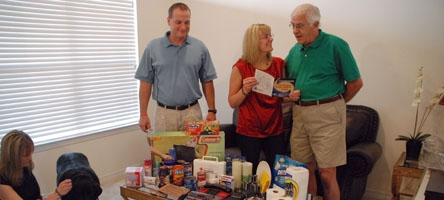
What is a tornado?
A tornado is a narrow, violently rotating column of air that extends from the base of a thunderstorm to the ground. Because wind is invisible, it is hard to see a tornado unless it forms a condensation funnel made up of water droplets, dust and debris.What is the difference between a tornado watch and warning?
A tornado watch defines an area shaped like a parallelogram, where tornadoes and other kinds of severe weather are possible in the next several hours. It does not mean tornadoes are imminent, just that you need to be alert, and to be prepared to go to safe shelter if tornadoes do happen or a warning is issued.A tornado warning means that a tornado has been spotted, or that Doppler radar indicates a thunderstorm circulation which can spawn a tornado. When a tornado warning is issued for your town or county, take immediate safety precautions.
What is the EF-Scale?
The Enhanced Fujita Scale rates tornadoes by the damage they cause. Tornado categories are from EF0 to EF5. The EF-Scale takes into account variables such as building type, structures, and the sizes of trees.TORNADO SAFETY: WHAT YOU CAN DO
Before the Storm:
- Develop a plan for yourself and your family for home, work, school and when outdoors.
- Have frequent drills.
- Have a NOAA Weather Radio with a warning alarm tone and a battery backup to receive warnings.
-
Listen to radio and television for information.
-
If planning a trip outdoors, listen to the latest forecasts and take necessary action if threatening weather is possible.

If a warning is issued or if threatening weather approaches:
-
In a home or building, move to a pre-designated shelter, such as a basement.
-
If an underground shelter is not available, move to an interior room or hallway on the lowest floor and get under a sturdy piece of furniture.
-
Stay away from windows.
-
Do not try to outrun a tornado in your car; instead leave it immediately.
-
If caught outside or in a vehicle, lie flat in a nearby ditch or depression.
-
Mobile homes, even if tied down, offer little protection from tornadoes and should be abandoned.

*A 3-day
supply of water (one gallon per person per day) and food that won’t spoil
*one
change of clothing and footwear per person
*a first aid kit including a battery-powered NOAA Weather Radio and a portable radio, flashlight and plenty of extra batteries
*an extra set of car keys and a credit card or cash
* special items for infant, elderly or disabled family members.
For more information visit: http://www.ready.gov/be-informed
*a first aid kit including a battery-powered NOAA Weather Radio and a portable radio, flashlight and plenty of extra batteries
*an extra set of car keys and a credit card or cash
* special items for infant, elderly or disabled family members.
For more information visit: http://www.ready.gov/be-informed

No comments:
Post a Comment